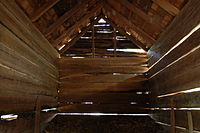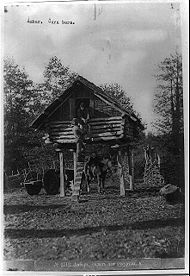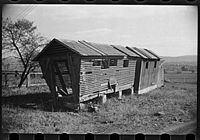- Corn crib
-
This article is about the granary used to dry and store corn. For the under-construction stadium in Normal, Illinois, see The Corn Crib.
A corn crib or corncrib is a type of granary used to dry and store corn. It is also known as a cornhouse or corn house, though this term can refer to any granary.[1]
After the harvest, corn, still on the cob, is placed in the crib either with or without the husk. The typical corn crib had slats in its walls. These slatted sides of the corn crib allow air to circulate through the corn, both allowing it to dry initially and helping it to stay dry. The slats expose the corn to pests, so corn cribs are elevated above the ground beyond the reach of rodents.
Corn cribs were first used by Native Americans and were quickly adopted by European settlers. Struggling European settlers often raided corn cribs for food. As a result, at least some Native groups abandoned the corn crib and buried food in caches (Johansen, 125).
Corn crib designs vary greatly. They were originally made of wood, but other materials such as concrete have also been used. The basic corn crib consists of a roofed bin elevated on posts. Another typical, early American design has walls slanted outward. Most of the larger designs have an open space in middle for accessing corn and promoting airflow. In larger designs, this space was often used to store wagons. By the early 20th century, the word "corn crib" was applied to large barns that contained many individual bins of corn.[1]
See also
References
- Bruce E. Johansen, ed., The Encyclopedia of Native American Economic History. Westport, CT: Greenwood Press, 1999.
- ^ Cornhouse entry in the Oxford English Dictionary
External links
Categories:- Agricultural buildings
- Native American architecture
Wikimedia Foundation. 2010.



